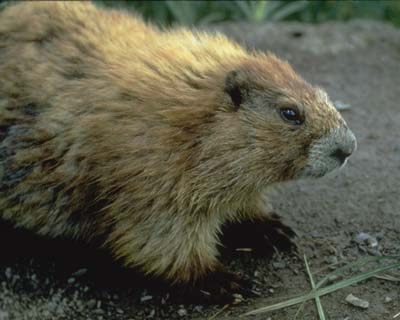- Olympic Marmot
Taxobox
name = Olympic Marmot
status = LR/lc | status_system = IUCN2.3

image_width = 200px
regnum =Animalia
phylum =Chordata
classis =Mammal ia
ordo =Rodent ia
familia =Sciuridae
genus = "Marmota "
subgenus = "Petromarmota "
species = "M. olympus"
binomial = "Marmota olympus"
binomial_authority = (Merriam, 1898)The Olympic Marmot, "Marmota olympus", is a
marmot (arodent in thesquirrel familySciuridae ). They are found in alpine andsubalpine meadows and talus slopes of theOlympic Peninsula ofWashington , and are close relatives of theHoary Marmot .Like most marmots, they are gregarious burrowing animals. A typical family consists of a male, two to three females and their young. New born marmots stay with their family for at least two years so a burrow will usually be home to a newly born litter and a year old litter. Female marmots have a litter of about four marmots on alternate years. The young do not reach sexual maturity until their third year, perhaps because of the short growing season.
Olympic Marmots hibernate from September through May. This is the most dangerous time for the Olympic Marmot and in years of light snowfall as much as 50% of the young born in that year will perish. After they come out of hibernation, their diet consists largely of roots until new vegetation appears in the spring, after which they feed on grasses, herbs, mosses and flowers as well as the occasional insect. Dry grasses are also brought into the burrows for bedding or food. Colonies are frequently found on southern-facing slopes as the earlier snowmelt leads to more food for the colony.
During the active months of June, July and August, the marmots forage in the morning and afternoon with a break around midday. Before each feeding period they visit the other burrows in the colony. The marmots greet each other by touching noses. During more extended greetings, they may touch nose to cheek and nibble on each other's ears and neck. They may also engage in play fighting in which two marmots on their hind legs push each other with their paws. The play fighting is more aggressive between older marmots.
Olympic Marmots, like all other marmots, have a variety of distinctive calls or whistles which alert other marmots to predators. There are four basic calls: ascending, descending, flat and trills. The first three calls are distinguished by relative frequency of their starting and ending pitch. The trills are a series of ascending calls in rapid succession and are the most rare, being reserved for situations of great danger. The flat calls are the most common. The calls can be heard [http://www.marmotburrow.ucla.edu/olympic.html here] . Common predators of the Olympic Marmot are the coyote and puma although the marmots have been observed making alarm calls for a number of large birds of prey as well as bears and bobcats.
Olympic Marmots are relatively easy to see on the very accessible
Hurricane Ridge inOlympic National Park where they are quite numerous. Olympic Marmots are in decline in some areas in the park. This is believed to be due to the encroachment of trees into the meadows as well as predation by coyotes. Olympic Marmots are a protected species in Washington.References
* Andrew J. Edelman, "Marmota Olympus," Mammalian Species, No. 736 (2003), pp. 1-5
*
* [http://www.nhptv.org/natureworks/olympmarmot.htm Olympic Marmots at Nature Works]
* [http://animaldiversity.ummz.umich.edu/site/accounts/information/Marmota_olympus.html Olympic Marmots at Animal Diversity Web]
* [http://www.marmotburrow.ucla.edu/olympic.html Olympic Marmots at The Marmot Burrow]
*Thorington, R. W. Jr. and R. S. Hoffman. 2005. Family Sciuridae. Pp. 754-818 "in" Mammal Species of the World a Taxonomic and Geographic Reference. D. E. Wilson and D. M. Reeder eds. Johns Hopkins University Press, Baltimore.
Wikimedia Foundation. 2010.
